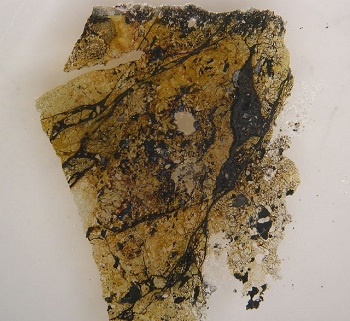A research team from the University of Las Vegas has provided more insight into Bridgmanite, the most abundant mineral on Earth.
 Image credit: Tschauneret et al, Science (2014).
Image credit: Tschauneret et al, Science (2014).
Bridgmanite is a highly dense form of magnesium iron silicate. For over half a century, scientists have been trying to discover, classify and characterise this mineral. This study has helped to define projected constraint ranges for the formation of the mineral.
The study was carried out using high-energy X-rays and a very old meteorite, at the Advanced Photon Source at DOE's Argonne National Laboratory, which is a U.S. Department of Energy (DOE) Office of Science User Facility.
Percy Bridgman was a pioneer of high-pressure research and is a 1964 Nobel laureate. This mineral was named in his honour. This discovery will help to advance our knowledge about the Earth’s composition.
Researchers have to test materials under conditions of extreme temperatures and pressure, in order to find out what the Earth’s inner layers are composed of. For a long time, it was considered that 38% of the Earth’s volume was made up of a dense perovskite structure. It was believed that Bridgmanite’s physical and chemical properties had a major influence on the flow of heat and elements through Earth’s mantle.
When collisions between asteroid bodies in the cosmos occur, the resulting shock-compression that takes place creates conditions that can be considered to be the same as that in the deep Earth. The pressure would be approximately 240,000 times greater than air pressure at sea-level and the temperature would be approximately 2,100°C.
The shock-compression that takes place is so rapid that it prevents the breakdown of Bridgmanite that occurs when it encounters a lower pressure, for example the conditions on Earth’s surface.
Bridgmanite freezes within a shock-melt vein in meteorites that fall on Earth. Previously researchers used transmission electron microscopy to analyse these meteorites but they caused radiation damage and results could not be derived.
Based on this knowledge, the researchers attempted novel fast-readout area-detector techniques and non-destructive micro-focused X-rays for diffraction analysis. X-rays possess high energy and intense brilliance that allow them to go through the meteorite without causing damage as they leave very little radiation behind.
Tschauner performed this analysis along with Caltech colleagues and the X-ray beamline operated by University of Chicago at Argonne National Laboratory - the GeoSoilEnviroCARS (GSECARS).
In 1879, meteorite Tenham crashed in Australia. The researchers studied a part of this highly shocked L-chondrite meteorite using GSECARS beamline.
However, in the Tenhma meteorite, Bridgmanite grains are rare. They have a diameter smaller than 1µm. The researchers employed a strongly focused beam and performed highly spatially resolved diffraction mapping. They performed this experiment until they identified an aggregate of Bridgmanite and also identified and characterised the mineral using structural and compositional analysis.
Natural Bridgmanite had some differences from synthetic samples. It had a large amount of ferric iron and more sodium. Natural Bridgmanite’s crystal chemistry provided new knowledge, and it may aid in further studies of deep mantle rocks.
Natural Bridgmanite remains stable only at pressures of more than 23 GPa and depths lower than 660km. When this material is brought to outer Earth, it changes into less dense minerals due to the lower pressures. Further, some scientists consider that certain inclusions in diamonds are those of Bridgmanite that changed when they were removed from the Earth.
The researchers have published their study titled "Discovery of bridgmanite, the most abundant mineral in Earth, in a shocked meteorite” in the journal Science.